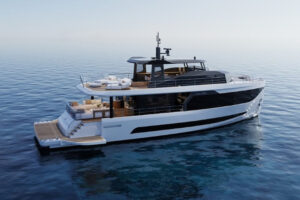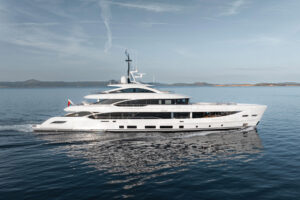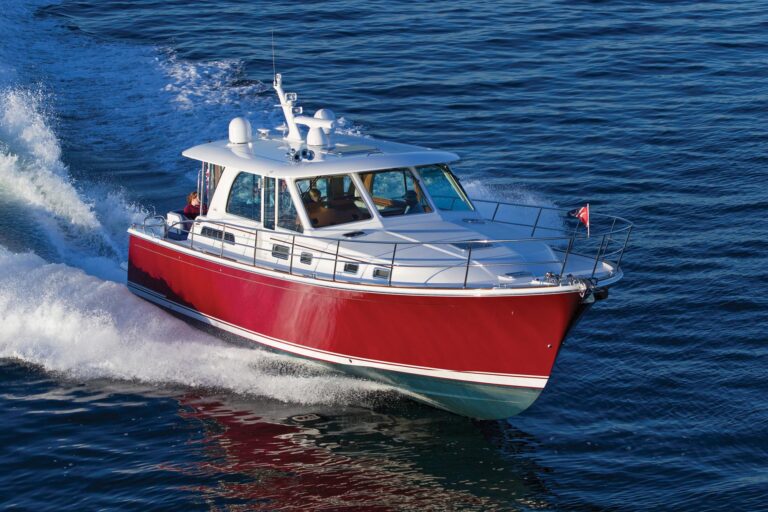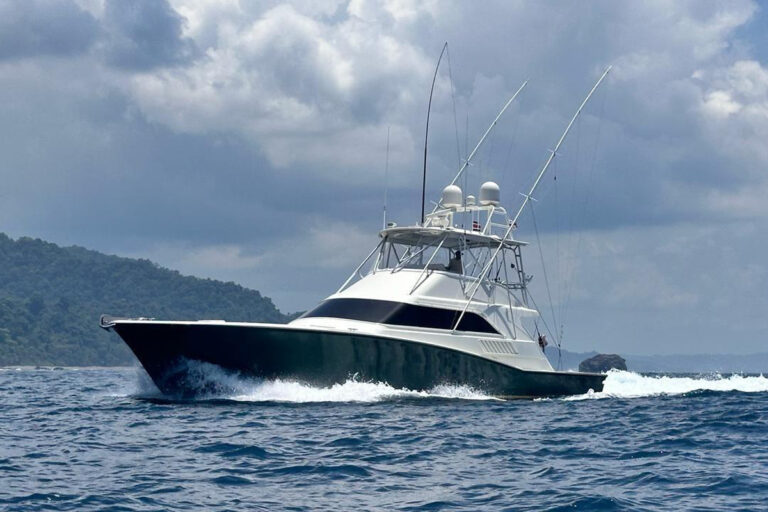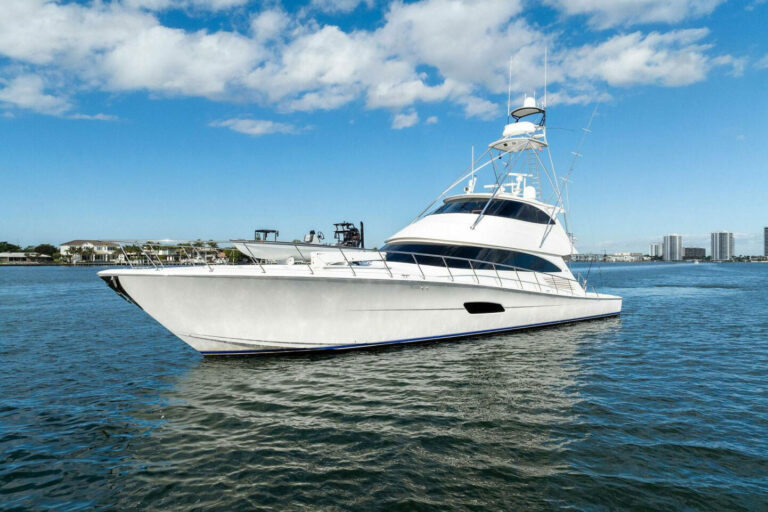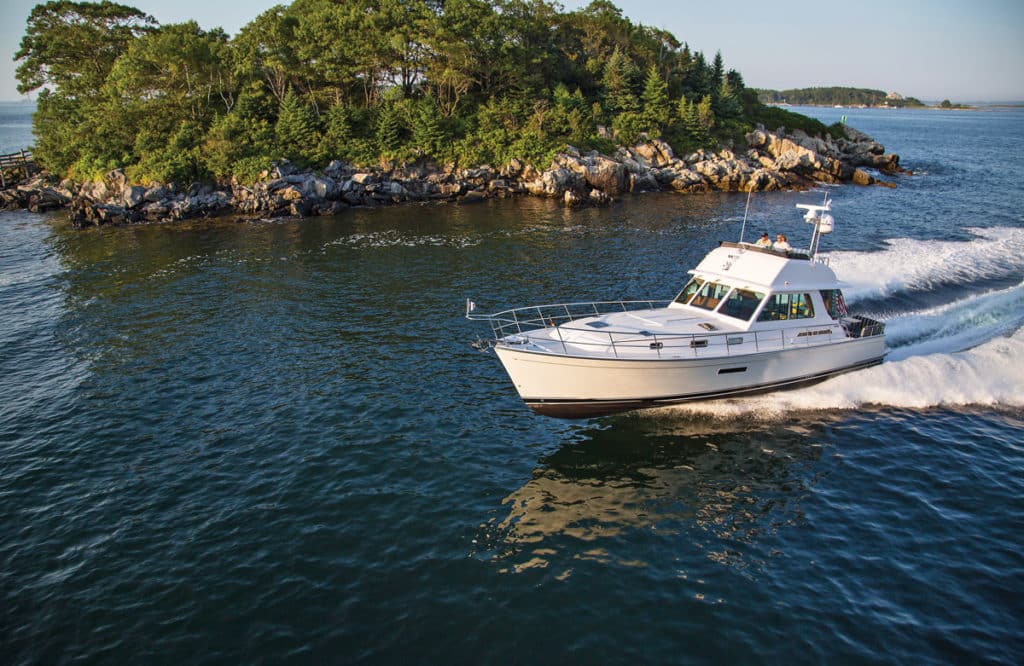
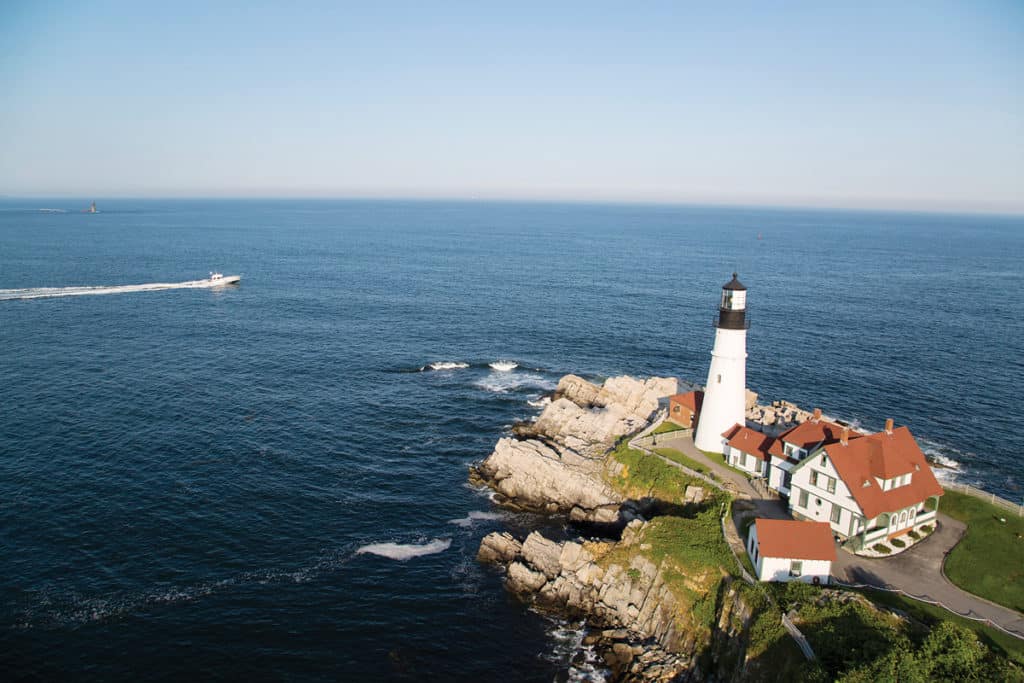


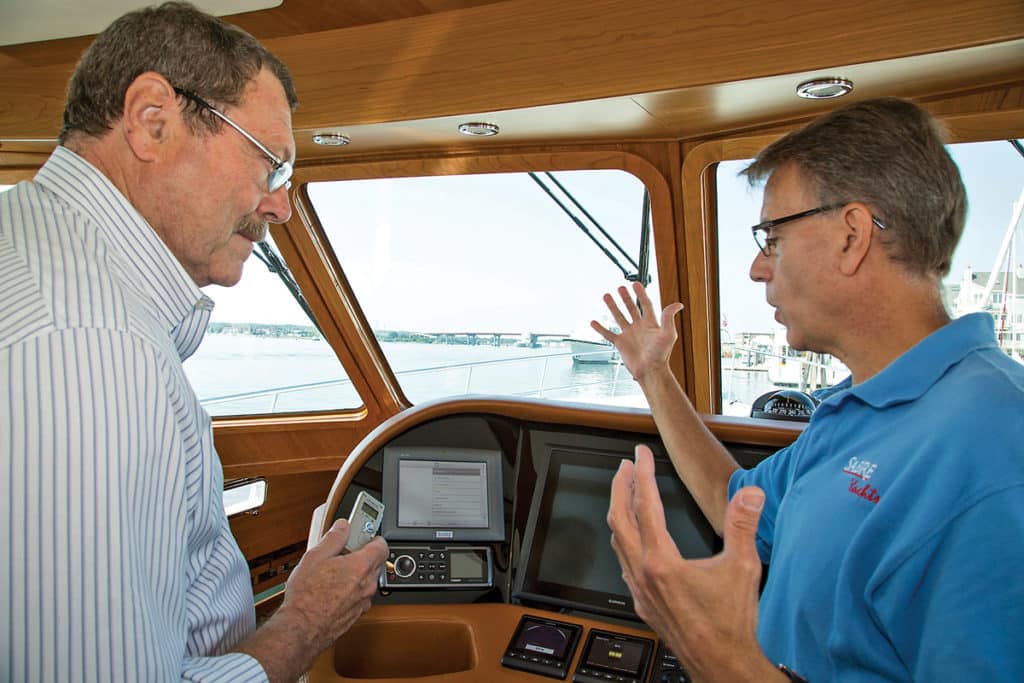
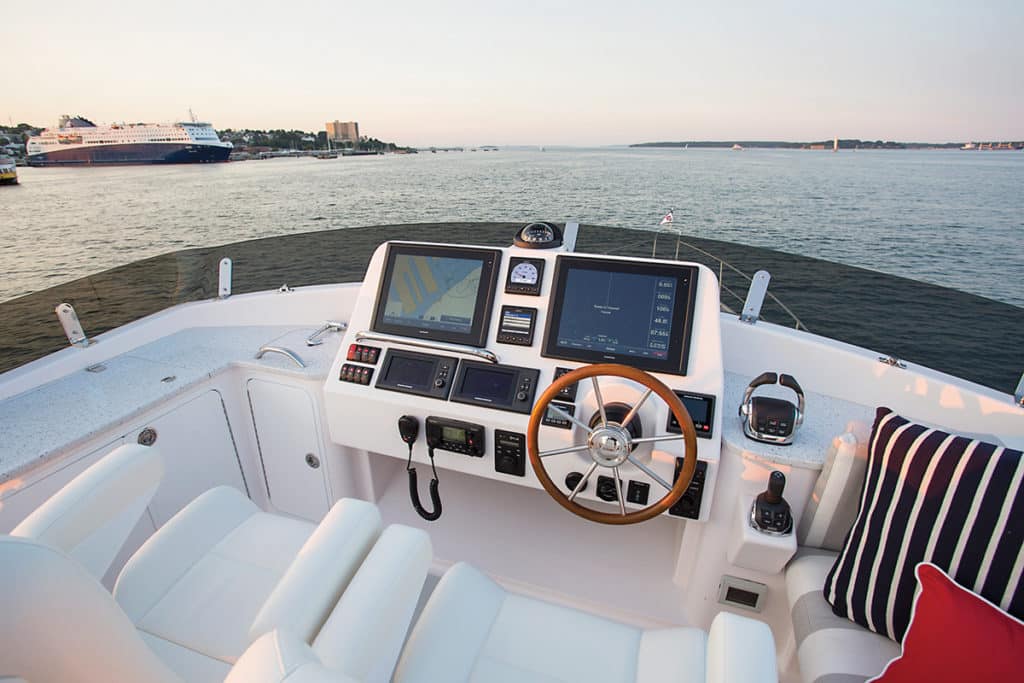
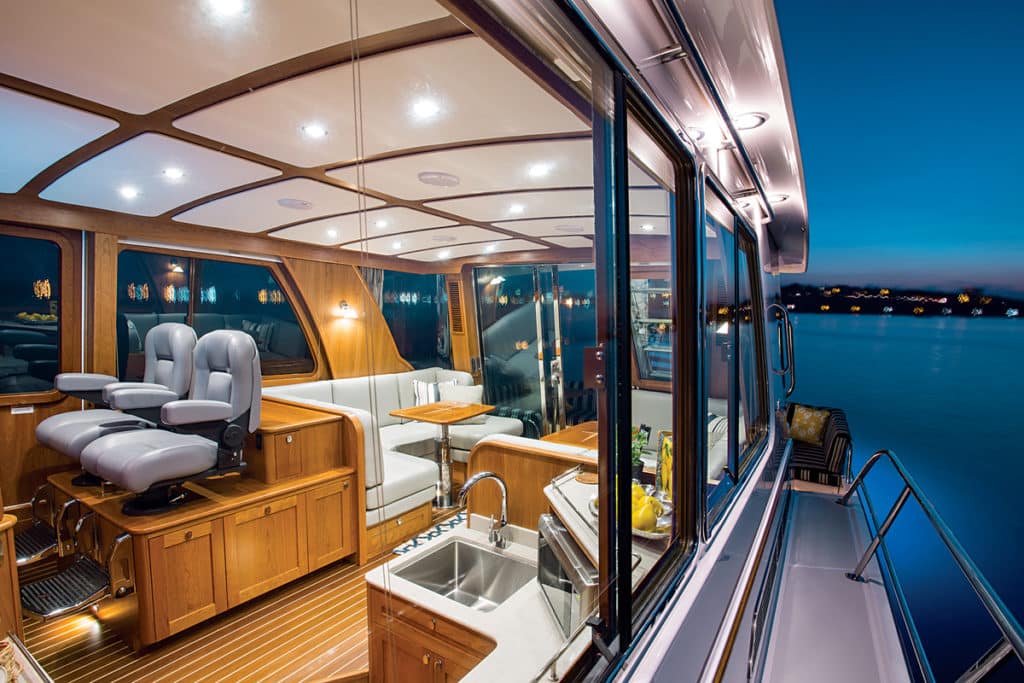
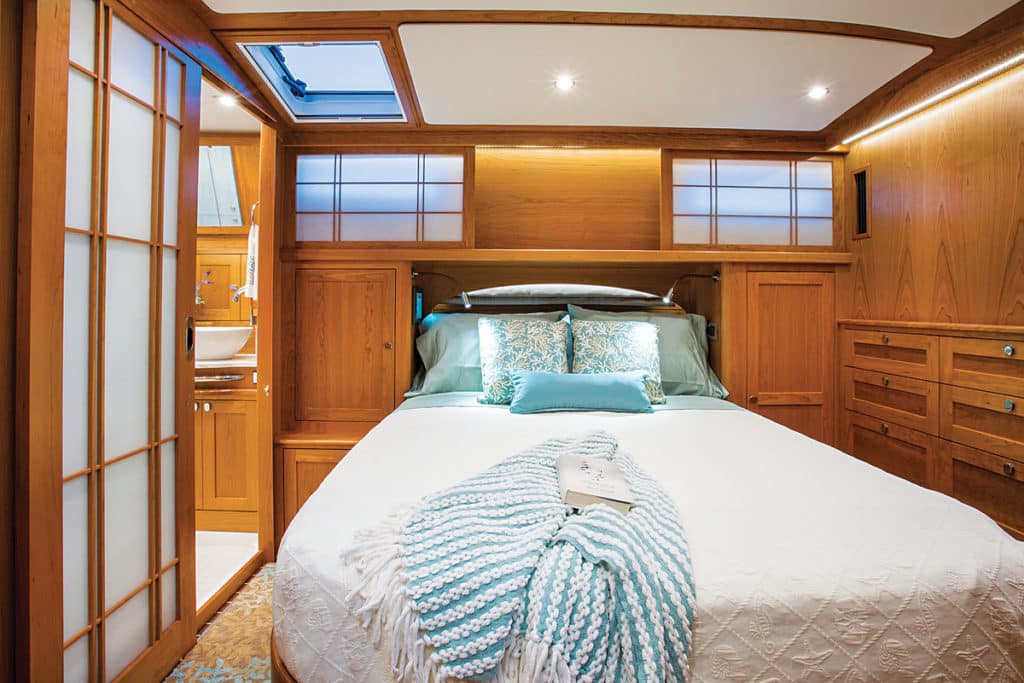
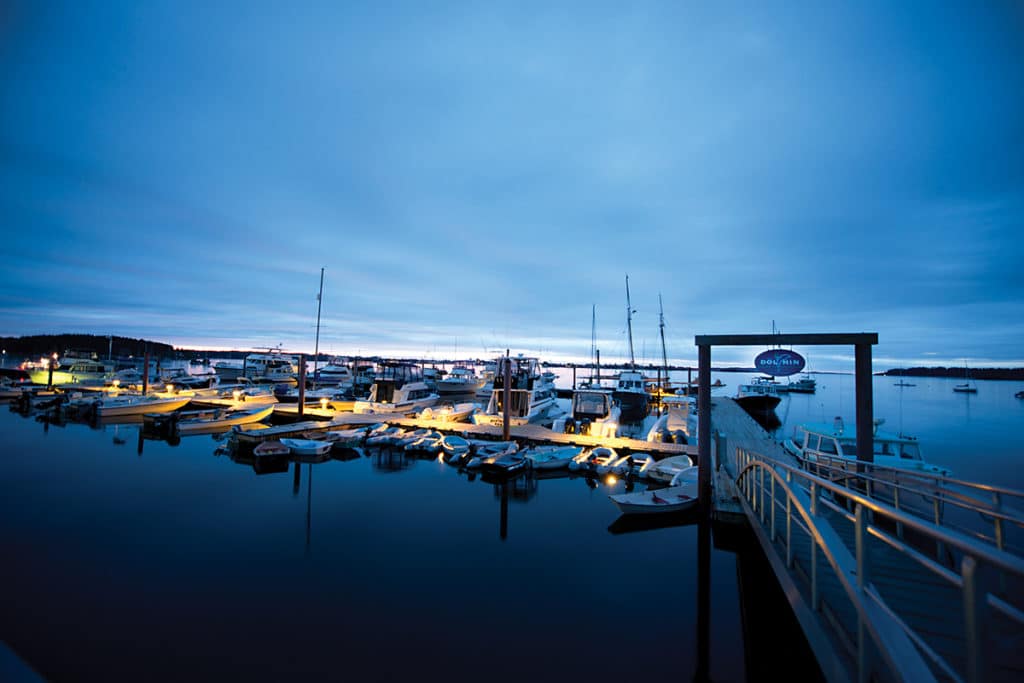
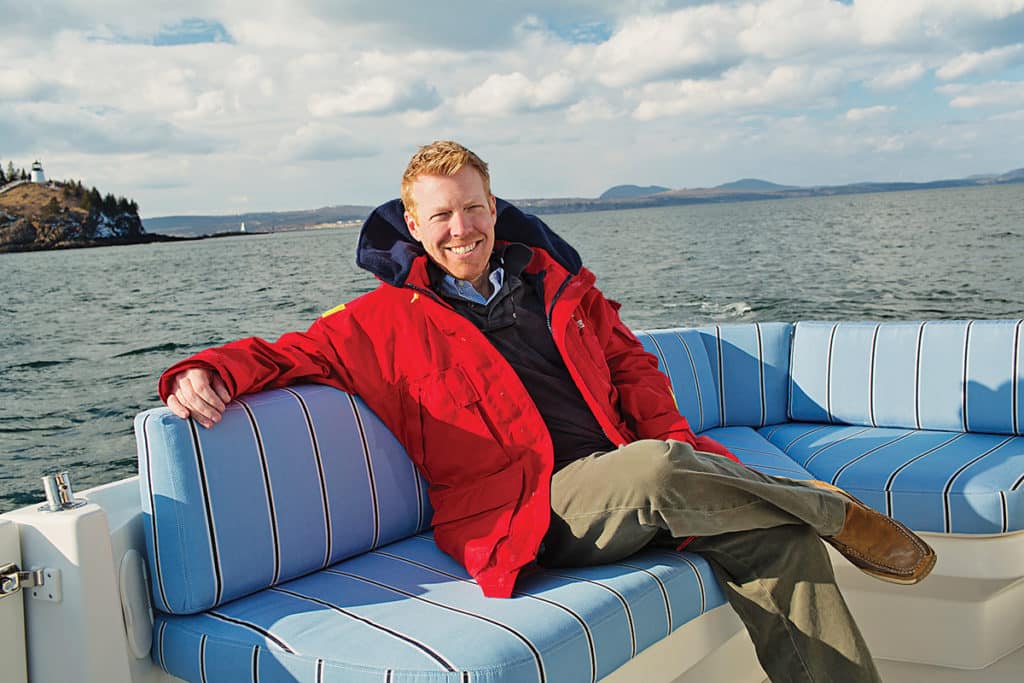
“We had fairly shallow prop pockets on the original 52 hull geometry, so switching to Volvo Penta’s IPS system required that we had to do some major mold work on the 54 to remove them. The geometry ended up with a rebuilt, warped running surface that measures 15 to 16 degrees deadrise at the transom, flattening out from amidships angles of 24 degrees deadrise. Most of our hulls have a modified-V shape, with planing and running efficiencies, as well as bow rise control, in mind. Chines are slightly reversed, gradually widening as they move aft, to help with spray control and planing. The bow is fairly straight, slightly raked with a fair bit of forefoot for a fine entry that immediately goes to high deadrise angles. We also eliminated the bow thruster tunnel. The IPS pods don’t require thrusters for dockside maneuverability. This was a benefit, because bow tunnels generate spray easily, always a challenge when you’re trying to keep decks and windshields dry.”
The view from the upper helm of the new Sabre 54 Fly Bridge Sedan was simply awe-inspiring. We had just departed DiMillo’s Marina and cleared the channel leading out of Portland, Maine. The day was sunny and bright, and the fantastic islands of Casco Bay and the open waters of the Gulf of Maine fanned out before us in a wide-angle canvas of trees, granite and clear sapphire water.
With its myriad islands and narrow passages, all of which beg exploring, Casco Bay offers hundreds of possibilities for navigating rocks and lobster pot floats alike, making for very interesting test grounds. Agile and powerful, the 54 FBS made short work of crossing wide-open stretches to reach distant destinations quickly, maneuvering in and out of mooring fields to admire classically beautiful boats of the region and slowing to accommodate the hard-working lobstermen who spend their lives on these waters.
Gradually, I pushed the throttles of the twin 725-horsepower Volvo Penta IPS2 950s forward, and she was up on plane in eight seconds, impressive for a yacht that tips the scales at 52,000 pounds with full tanks and our four-man crew. With the gauges showing 30.2 knots at 2,200 rpm, fuel consumption was a modest 55 gph, giving a range of 343 nautical miles with a 10 percent fuel reserve. Time to 30 knots: 14 seconds. Sabre recommends this speed for maximum continuous cruise, which paired well with our test day’s 1-foot seas.
The 54 was first made available as a hardtop sedan, called a Salon Express, and both that and the FBS are based on the company’s 52-foot hull, which originally was powered by straight-shaft Caterpillar C15s. “The market increasingly calls for pod drives,” said Bentley Collins, Sabre’s vice president of marketing and sales. “Performance, fuel economy, boat control and low-speed handling with the joystick control all improved. And since the 54’s Volvo Penta D11 diesels are not close-coupled to the IPS2 drives, but are located farther forward and connected by jackshafts, the balance and feel of the boat remain true to those of the 52.”
The 54 brings owners a new third cabin on the port side with bunks, more comfortable seating in the main salon, a cockpit shade and more seating in the cockpit, which is more closely connected to the seating in the main salon. A not-so-obvious improvement is that the aft cockpit sole has been raised, eliminating a space-consuming step leading up to the salon. “It’s a huge improvement for those moving between the salon and the cockpit, and we gained seating for seven aft,” Collins said. From my perspective, the lines of the boat aft seem little affected, very much in keeping with the modestly springy sheer and the classic deckhouse lines of the older 52.
Whether you’re seated in one of the salon lounges or ensconced in the twin Stidd helm chairs, views and sight lines are remarkable. The exterior stainless-steel staircase leading up to the flybridge impinges a bit on the salon interior space, but a window lets the helmsman or guests look between the teak treads. Clever. Combine that with the vessel’s curved-glass corner windows and you have a light, bright salon that is as perfect for entertaining as it is for navigation.
Like every Sabre yacht, the interior is a masterful blend of traditional and contemporary influences. A teak-and-holly sole runs from the salon forward to the guest stateroom, past the portside office space and the shoji-screened master stateroom to starboard. American cherry is the predominant surface for bulkheads and built-in furniture, nowhere more lovingly used than in the ceiling strips lining the sides of the guest stateroom. A range of designer fabrics allows new owners lots of latitude in the final, elegant look tying the interior spaces together and spilling outside onto aft cockpit seating.
For those who are deeply into entertaining, or the efficient preparation of exceptional meals for the crew, the midlevel galley to port is equipped with a Sub-Zero two-drawer refrigerator and freezer, a convection/microwave oven and a Fisher Paykel dishwasher, all below generously sized quartz countertops. Locker and drawer space is more than sufficient for long weeks of cruising.
Safety-conscious owners who prize wide side decks with plenty of handholds and safety rails will agree that the Sabre 54 truly shines. Moving around to handle lines or monitor anchoring could not be safer. And there is a stout, waterproof door just to starboard of the helm, making it easier for a short-handed operator to slip outside and handle lines, once he or she has gently maneuvered the 54 next to the dock with Volvo Penta’s joystick system.
Beneath the skin of ISO NPG gelcoat, Sabre uses VIP resin-infused laminates with knitted biaxial structural reinforcements and SAN Corecell foam coring, which Collins told me has helped achieve a 10 percent reduction in fiberglass parts’ weight compared with the 52’s. Lessons learned over the years in system component selections are well represented by 59,000 Btu of air conditioning with reverse-cycle heating, and a 13.5 kW genset big enough to supply all the power needed with every electrical component online, just to name two.
One of the more interesting new systems used aboard the 54 is a touch-pad-controlled, distributed power system that integrates Mastervolt components and the NMEA 2000 network. “This is the first boat on which we have installed a network control system, giving the owner digital control of everything from pumps, lighting, heating, air conditioning, engine room ventilation control and more,” said Dave Newcombe, engineering manager for Sabre.
The capabilities of the Mastervolt system, as explained to me by Newcombe, are myriad, and I urge you to take a demonstration ride on the new Sabre 54 Fly Bridge Sedan to see them in use. Everywhere you look, this elegant vessel exhibits the traditional care and skills of Maine’s boatbuilding craftsmen, blended with leading-edge technologies and equipment that can make your time on the water enjoyable.
Sabre Yachts, 207-655-3831; sabreyachts.com


